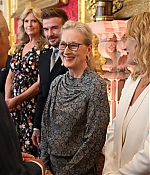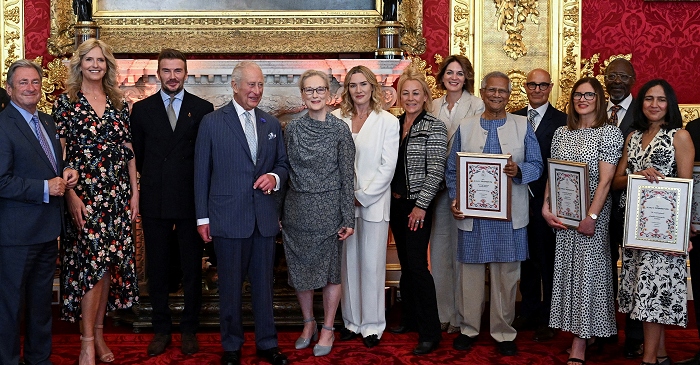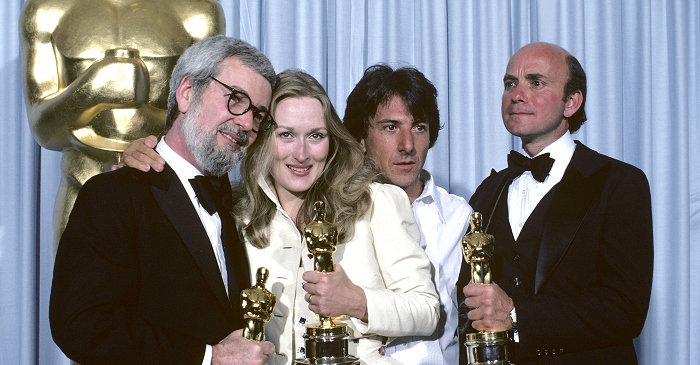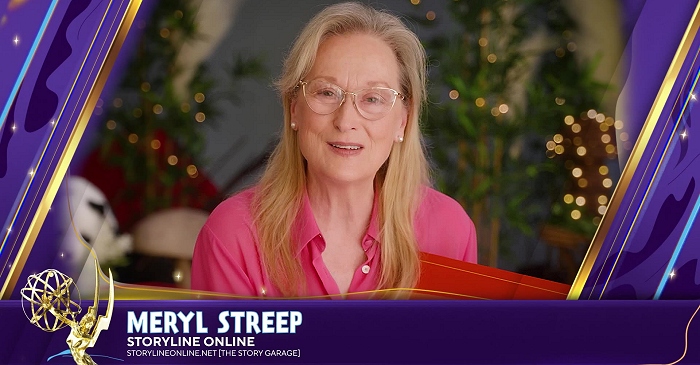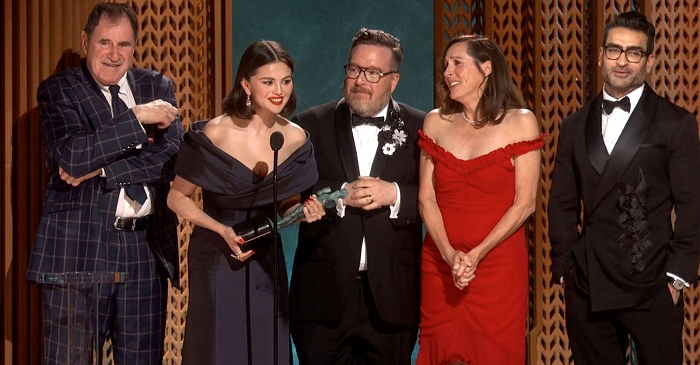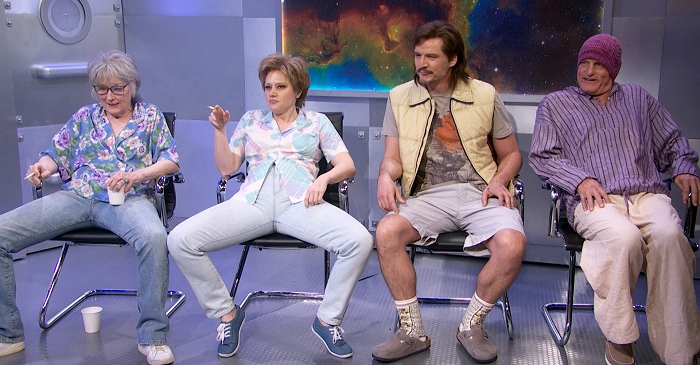|
Simply Streep is your premiere online resource on Meryl Streep's work on film, television and in the theatre - a career that has won her acclaim to be one of the world's greatest living actresses. Created in 1999, Simply Streep has built an extensive collection over the past 25 years to discover Miss Streep's body of work through thousands of photographs, articles and video clips. Enjoy your stay and check back soon.
|
|
Just an Ordinary Connecticut Housewife
The Los Angeles Times ·
November 06, 1988
· Written by Charles Champlin
|
There is nothing like being attacked for something you do superbly well. It’s as if the hole-in-one were a terrible bore, the grand slam just another hit, the checkered flag only a piece of cloth. Meryl Streep does accents, does them so well that for a couple of hours of screen time it’s hard to imagine that she ever talks any other way. The accents-Sophie’s Polish, Isak Dinesen’s Danish, Karen Silkwood’s Southwest among them-are so unforced and natural that they seem to flow from the marrow of her bones. They give her the character, she says, the way a wig or a putty nose or spectacles or a beard will give another actor a character.
“But I get a lot of flak for my accents,” Streep said during a brief visit to Los Angeles a few days ago. It is more exasperating than hurtful for her and she has no intention of changing, although, she added, “Once in a while I think it would be a relief to play a housewife trying to raise three kids, keep her husband happy and organize her neighbors to fight pesticides.” Streep is in fact a Connecticut housewife doing all the above. Her children are now 8, 5 and 2; her sculptor husband Don Gummer is happy and she is working hard to organize a campaign against pesticides on the produce in the local markets. (“California is quite good about that,” she says. “Connecticut isn’t.”) She has become a walking glossary of chemicals and their carcinogenic properties. She has also added a new, Australian accent to her repertoire and, like the others, it is so understated and natural that it’s difficult to believe she wasn’t born within sight of a kangaroo or two.
The film is “A Cry in the Dark,” which opens Friday and is based on the extraordinary true story of Lindy Chamberlain, who served more than 3 years in prison for the murder of an infant daughter she insisted had been carried off by the Australian wild dog called the dingo. Only in mid-September were Mrs. Chamberlain and her husband, a Seventh-day Adventist minister, finally acquitted on all the charges against them. She had been released from prison earlier on compassionate grounds. His sentence as an accomplice had been suspended so he could care for the children, including a daughter born just as his wife went to prison. “There were 350 speaking parts in the film,” Streep says, “and I was the only ringer, the only non-Australian. I was worried that all those actors would say, ‘What’s this girl doing here?”‘ The question, it seems clear, did not arise.
“I was trying to reproduce the way one person speaks. I met Lindy and spent an intense time with her. But we held the meeting sort of at arm’s length. When we were shooting she was still a convicted murderess even though she’d been released. “Her appeals had been rejected three times and it took an act of the legislature before a fourth appeal could be heard. They were working on that while we were there. “I was walking on eggshells. I feared I’d screw it up for her, wreck it for her somehow. I worried that the film could hurt her chances of being exonerated.”
At the time Streep’s third child was born, a friend had given her a copy of “Evil Angels,” John Bryson’s book about the case, on which the film is based. “I read about 40 pages and put it aside. It was not what you want to read when you have a new baby of your own.” Later, when she was sent the script by Robert Caswell and Fred Schepisi, who directed “A Cry in the Dark,” she found that the story’s resonances were still strong. When she and Lindy Chamberlain finally met, Streep says, “She was 10 times the woman I ever thought would walk in the room.”
What fascinated Streep was how the Chamberlains, perceived at first simply as the victims of a terrible tragedy, should so swiftly have come to be seen as deceivers, killers, possible partners in a ritual murder, perhaps an atonement related to their not-well-understood religion. “What was interesting to me as an actress was why was she convicted. What is it in the public that wants to see its blackest fears played out? There was something about the way she behaved, the way she held herself, the way she set her face, the way she appeared on television that changed the way people felt,” Streep feels. The couple’s comforting faith, that the disappearance of their child was God’s will, incomprehensible as that might be, looked less like resignation than indifference.
“The Chamberlains didn’t have packagers or handlers. They didn’t seem to make an appropriate expression of grief, although I don’t know what that is, frankly. She wasn’t seen to grieve-although she did-and therefore she was seen as guilty. It was the kind of woman she was, holding back, being strong.” The story became a press circus and the notoriety turned suspicions into certainties, rumors into facts. The press, indeed, does not look wonderful in the film. But having helped to make the mischief, Streep says, the press then helped correct a miscarriage of justice by keeping the story alive during the months of legal to-and-froing after Mrs. Chamberlain went to prison. “There’s a line in the movie, somebody complaining about the press flogging a dead horse, and that’s what the public began to think. But they kept the matter going. Some people aren’t convinced she was innocent, even now. I still hear theories about what really happened.” (The movie is unambiguous about her innocence.)
Michael Chamberlain became the archivist of the case, obsessed by it. Their living room is so packed with file cabinets there’s hardly room to walk. The Chamberlains may sue the Northern Territories, and it is possible that the laws covering the use of forensic evidence may be changed. For Streep and the cast it was a rough shoot, including 10 days of 122-degree weather at Alice Springs near Ayres Rock, where the Chamberlains were camping in 1980 when the child disappeared. “I haven’t been so hot since I worked on ‘Silkwood’ in Texas. I was wearing a wig which was like a fur hat. I covered the children in 26-level suntan lotion, which they hated because it ran in their eyes when they perspired.”
There were several kinds of heat, actually. “You usually have accountants looking over your shoulders. We had the law, the press, the government and the people who’d been victimized.” The Australians, says Streep, “will hate me saying it, but they’re very American. So much of what they see on television is American. It seemed very familiar, being there. I thought the story was a cautionary tale for us. It has applications here, too. It plays on our deepest fears and it’s horrific, but it’s a soaring thing as well, because justice is served, finally.” Streep says, “I really would love to play a housewife with environmental concerns, but they don’t make movies about them. I don’t go looking for parts with accents, but I’m drawn to what hits me in the solar plexus. I need to engage on that level, to do roles that have something to say.
“The whole process of production will drive you mad if you don’t have that total commitment. “I’m interested in crawling into other people’s skins, seeing the world through their eyes, explaining people who might otherwise seem incomprehensible. It probably helps that I don’t try to impose anything of myself.” The paradox of the known performer, the star performer in fact, disappearing into the role is particularly remarkable with Streep. The characters she has played are not Meryl Streep. She is none of the characters she has played.
“I’ve always thought of acting as that disappearing act, always,” she says. “At 8 I thought I was the Virgin Mary. It may be the closest I’ve come. I love the aspect of pretend, the created reality. I’m the kind of actor who aspires to be a transforming actor.” She figures next to transform herself into “Evita.” “It’s been offered,” she says. It won’t start until October 1989, allowing plenty of time for singing lessons. Her husband tells her, kiddingly, it may be the first funny thing that she’s done. She’d like to do a comedy, as a matter of fact, a sophisticated comedy, perhaps, with the usually urbane and witty Sam Neill, who plays her earnest, humorless husband in “A Cry in the Dark.”
“I just haven’t gotten many comedies. I’m a sucker for the powerful story. I could do the easy thing and not have to go and kill myself each time. I don’t know why I do, but it’s the way I am.”


